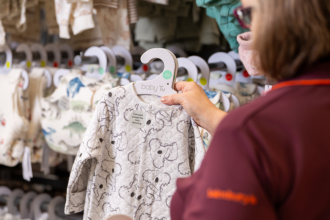Barkers are no new kid on the block. The iconic Kiwi bloke brand has been around since 1972, but they are by no means behind the times. If you’ve visited their new guide store in Ponsonby, you will have noticed the large flat screens perched on the walls. The monitors display Barker’s website, which at first glance may seem superfluous given that visitors are already in a Barker’s store, but nothing could be further from the truth. According to Glenn Cracknell, Barker’s General Manager, the screens were a simple way to make up for lack of space. Setting up a store inside a small, converted villa might seem like the average experience for a Ponsonby store-owner but add in Barker’s Groom Room and Archie’s Cafe from Mr Toms, and there isn’t a whole lot of shelf space. “Working with limited space, we had to include only certain styles, but still wanted to give customers the option of browsing the entire collection,” said Cracknell. Technology provided the solution, but Cracknell faced a variety of options for potential solutions. “Smaller screens are hard to navigate, so we decided to use the large, touch-enabled screens.”
The formal name is ‘omni-channel’, and it’s somewhat of a buzzword. Referring to the integration of digital, social media and bricks and mortar, omni-channel is increasingly popping up in both small and large retailers wanting to keep up with the times. “People still want to go to a store, still want to touch garments and try things on,” explained Cracknell. However, the abilities online and the many facets of modern websites can offer add value to shoppers in addition to a bricks and mortar presence. “A trend we have seen more of is customers visiting shops during the day, especially during lunch hours, and then purchasing online after hours,” he noted. The reason: increased convenience. The shopper does not have to deal with cash registers, shop assistants, POS systems or carrying shopping bags around with them. From a store perspective, the customer experience is more intimate and engaging, retail assistants are now be more focused on styling and helping the customers find the right products, instead of trying to close the sale. Additionally, this change in buyer behaviour also means a shift in the physical layout of the store. When the majority of shoppers are not concerned with purchasing, there is no need to have a traditional counter, something Barker’s guide store dispensed of. Instead, they use iPads, which connect with their POS system via the internet. Transacting on a device quickens the process, and means that the whole purchase system is more relaxed - customers can sit down and have a coffee while paying for their new goods and a lot of the formality in the purchase process is gone.
For smaller retailers, integrating technology into bricks and mortar stores may sound expensive. “There are so many options now,” said Cracknell. “Many POS systems have smaller costs and can offer different cost plans to different sized businesses.” It all boils down to consumer demand, which is strongly swaying towards convenience and more digital processes. Granted, some capabilities such as Paywave have higher transaction costs, but consumer expectations mean not having it can be detrimental. “Businesses who don’t make the switch will fall behind,” added Cracknell. “Having digital and physical integration gives a store the ‘wow-factor’.”






